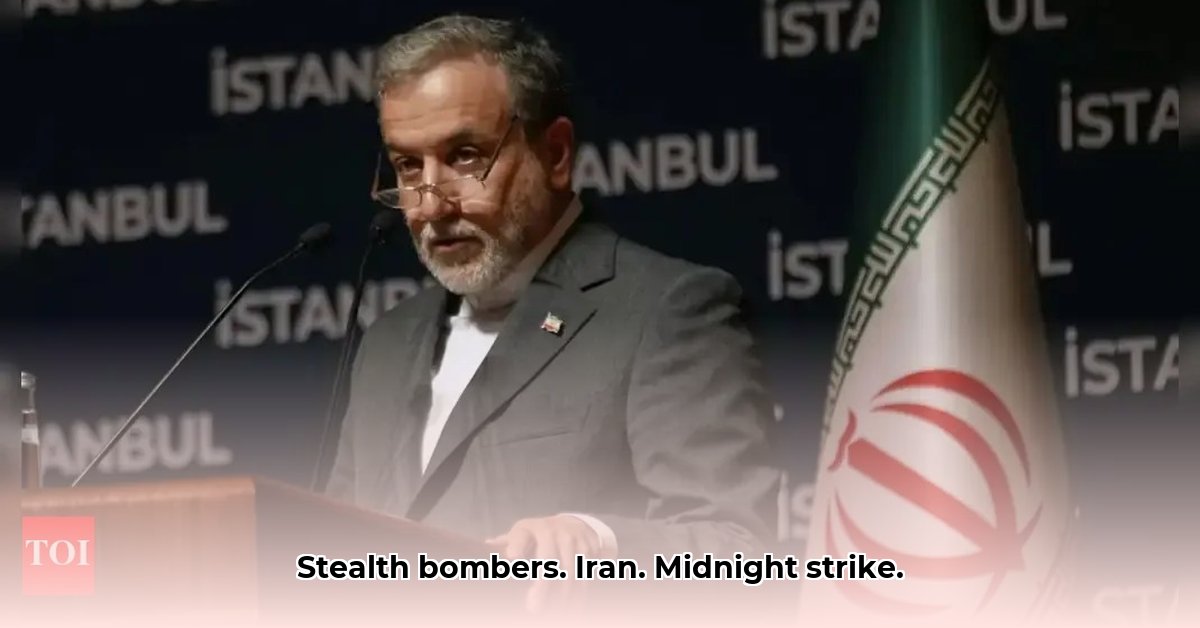
The June 2025 Raid: A Surgical Strike or a Calculated Gamble?
On the night of 22 June 2025, a dramatic escalation in US-Iranian tensions unfolded with Operation Midnight Hammer, a surprise attack on Iranian nuclear facilities. Seven B-2 Spirit stealth bombers, supported by over 125 other aircraft—including tankers and electronic warfare jets—launched a coordinated assault on the Fordow, Natanz, and Isfahan nuclear sites. Simultaneously, Tomahawk cruise missiles, fired from an undisclosed submarine location, targeted additional infrastructure. A significant decoy deployment to Guam aimed to further confuse Iranian defences. Initial US claims suggested the operation was a complete success, but leaked intelligence suggests a less decisive outcome, raising questions about the operation's true effectiveness and the accuracy of initial damage assessments. For more on air power, see this analysis of the AC-130 gunship: Goliath Gunship.
Operational Details: Conflicting Narratives and Uncertainties
The operation employed a multi-layered approach. The B-2 Spirit's stealth capabilities were crucial in achieving surprise. However, the effectiveness of electronic jamming in suppressing Iranian air defenses remains uncertain. Furthermore, while the US presented the operation as a surgical strike minimizing civilian casualties, independent verification of this claim remains challenging due to conflicting reports. The extent of the damage inflicted on Iranian nuclear facilities is still debated, with discrepancies between US official statements and leaked intelligence assessments. This raises important questions about the transparency surrounding the operation and the reliability of information disseminated in the aftermath. Did the US exaggerate its success to achieve political objectives? The uncertainty surrounding the operation's true outcome continues to fuel debate.
Geopolitical Implications: A Shifting Regional Balance
The immediate aftermath saw widespread international condemnation of the US action, particularly concerning its legality under international law. Iran responded with strong rhetoric and veiled threats of retaliation, escalating regional tensions. Israel, a close US ally, also had to navigate the complex fallout generated by this operation. The potential for a broader conflict – or a significant shift in the regional balance of power – cannot be discounted. Furthermore, the possibility of Iran accelerating its nuclear program in response to the attack will influence regional stability in the coming years.
Technical Analysis: Stealth, Precision, and Limitations
Operation Midnight Hammer showcased advanced military technology, notably the B-2 Spirit's stealth capabilities and the precision of the Tomahawk missiles. However, the operation also highlighted the limitations of these technologies. The high cost of maintaining and deploying the B-2 fleet, coupled with their inherent vulnerabilities to advanced air defense systems, raises concerns about the long-term sustainability of this approach. Furthermore, the reliance on electronic warfare raises questions about its effectiveness against sophisticated anti-access/area-denial (A2/AD) systems. The operation serves as a reminder that technological superiority is not a guarantee of success, and continuous adaptation to countermeasures is crucial.
| Technology | Effectiveness (Initial Assessment) | Risks | Possible Countermeasures |
|---|---|---|---|
| B-2 Spirit Bombers | High (disputed) | High cost, limited numbers, vulnerability to advanced defences | Advanced air defences, improved intelligence gathering |
| Tomahawk Cruise Missiles | Moderate (disputed) | Interception risk | Improved missile defence systems |
| Decoy Deployments | Uncertain | Could fail completely | Advanced detection systems to identify decoys |
Legal and Ethical Considerations: A Moral and International Law Quandary
The legality of Operation Midnight Hammer under international law, particularly the UN Charter's prohibition on the use of force, is highly questionable. The potential for civilian casualties, even if unintentional, raises significant ethical concerns. Furthermore, the potential for unintended consequences, including a wider regional conflict or escalation of the nuclear arms race, demands careful consideration. The operation highlights the complex interplay between national security interests, international law, and moral responsibility in modern warfare. What are the long-term consequences of such unconventional actions?
Conclusion: Uncertainties and Future Implications
The long-term consequences of Operation Midnight Hammer remain uncertain. The operation's actual impact on Iran's nuclear program, the stability of the Middle East region, and the future of US-Iranian relations are all subjects of ongoing debate and analysis. The operation highlights the inherent complexities and risks of military intervention in a volatile geopolitical environment, underscoring the need for careful assessment of both the immediate and long-term implications before such actions are taken. The continued divergence of information about the event highlights the limitations of relying solely on official sources and the importance of independent verification in assessing outcomes.